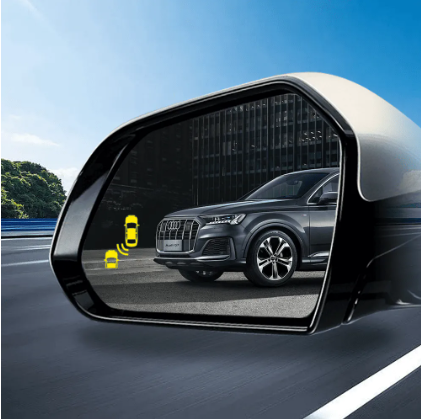Kernfunktionen von ADAS-Dashcams
ADAS-Dashcams bedeuten einen großen Fortschritt in der Fahrzeugsicherheit, wenn wir fortschrittliche Fahrerassistenzsysteme mit herkömmlichen Fahrzeugkameras kombinieren. Ihre Besonderheit liegt in der Fähigkeit, ständig das Geschehen rund um das Fahrzeug zu überwachen, wodurch Fahrer auch bei mangelnder Aufmerksamkeit unterstützt werden. Die meisten ADAS-Dashcams verfügen über mehrere wesentliche Funktionen, darunter Kollisionswarner, Spurhalteassistenten und automatische Erkennung von Verkehrszeichen. Diese Geräte funktionieren dank verschiedenster Sensoren am Fahrzeug, die kontinuierlich Umweltinformationen sammeln und schnell verarbeiten, um Kollisionen bereits im Vorfeld zu vermeiden. Branchendaten zeigen, dass Fahrzeuge mit diesen Systemen insgesamt weniger Unfälle verzeichnen. Automobilhersteller setzen diese Technologie zunehmend ein, da sie deutlich ihre Verpflichtung zeigt, die Verkehrssicherheit durch intelligente Überwachungslösungen zu verbessern.
Wie ADAS sich von Standard-Dashcams unterscheidet
Herkömmliche Dashcams filmen hauptsächlich das, was beim Fahren passiert, aber ADAS-Dashcams leisten etwas anderes. Sie geben Fahrern Echtzeit-Warnungen und Benachrichtigungen, wodurch sie zu deutlich mehr als nur Aufnahmegeräten werden. Normale Dashcams speichern Videos, damit Nutzer nach Ereignissen zurückblicken können, während ADAS-Systeme aktiv analysieren, wie eine Person fährt, und die Umgebungsbedingungen überprüfen, um vor Problemen zu warnen – und zwar bevor diese überhaupt auftreten. Das Unterscheidungsmerkmal ist, dass sie herkömmliche Videoaufzeichnung mit intelligenten Fahrassistenten kombinieren, wie sie die meisten Dashcams nicht bieten. Das Ergebnis? Weniger Unfälle, da Fahrer rechtzeitig vor Gefahren gewarnt werden, die Standard-Dashcams einfach übersehen. Beim Vergleich von ADAS-Dashcams mit regulären Modellen wird diese zusätzliche Sicherheitsebene für jeden, der Wert auf Sicherheit im Straßenverkehr legt, schnell offensichtlich.
Hauptmerkmale von ADAS-Dashcams
Kollisionswarnsysteme
Kollisionswarner bilden einen wichtigen Bestandteil moderner ADAS-Dashcams, da sie helfen, Unfälle zu vermeiden, indem sie Fahrer rechtzeitig warnen, wenn etwas auf sie zukommt. Die Technik hinter diesen Systemen umfasst verschiedene Sensoren sowie recht intelligente Software, die genau berechnet, wie weit entfernt sich andere Fahrzeuge oder Objekte relativ zu unserem eigenen Fahrzeug bewegen. Wenn die Gefahr zu nahe kommt, gibt das System laute Warnungen über Lautsprecher aus, damit Fahrer schneller als gewöhnlich auf die Bremse treten können. Studien haben gezeigt, dass Fahrzeuge mit Kollisionswarnsystemen tatsächlich weniger Unfälle haben als solche ohne diese Systeme, was erklärt, warum viele Hersteller diese Funktion mittlerweile serienmäßig in neuen Modellen anbieten, die auf den Märkten im ganzen Land erscheinen.
Spurfahr-Assistenten
Spurverlassenswarnungen zählen zu den wichtigen Funktionen in ADAS-Dashcams, die dazu beitragen, die Fahrer auf der Straße sicherer zu machen. Wenn jemand versehentlich aus seiner Spur abdriftet, greifen diese Systeme mit Warnungen ein, damit der Fahrer rechtzeitig korrigieren kann, bevor etwas Schlimmes passiert. Einige neuere Modelle gehen sogar noch einen Schritt weiter und lenken das Fahrzeug bei Bedarf sanft zurück in die Spur, wodurch jene Art von Unfällen reduziert wird, bei denen Fahrer für einen Moment unkonzentriert sind. Besonders nützlich an dieser Technik ist, dass sie während der Fahrt unmittelbares Feedback gibt und es den Fahrern so ermöglicht, sich besser auf das Geschehen um sie herum zu konzentrieren, anstatt den ganzen Tag über ständig prüfen zu müssen, ob sie sich in ihrer Spur halten.
Echtzeit-Fahrerassistenz
Moderne ADAS-Dashcams sind mit Echtzeit-Assistenzfunktionen wie adaptivem Tempomat und Erkennung des toten Winkels ausgestattet. Ihre besondere Bedeutung liegt darin, dass sie die Fahrer stets über das Geschehen rund um ihr Fahrzeug informieren, was zu deutlich sichererem Fahren in Situationen mit starkem Verkehr und eingeschränkter Sicht führt. Der adaptive Tempomat regelt die Geschwindigkeit automatisch, je nachdem, wie sich die Fahrzeuge vor einem verhalten, während das System für den toten Winkel Warnungen ausgibt, sobald sich etwas in diesen schwer einsehbaren Bereichen neben dem Fahrzeug befindet. Insgesamt ergibt die Kombination all dieser Technologien ein beeindruckendes Unterstützungspaket für alle Fahrer, die im Alltag oder auf längeren Strecken zusätzliche Hilfe benötigen, um sicher unterwegs zu sein.
Parküberwachungsfähigkeiten
Die in diese ADAS-Dashcams eingebaute Parküberwachung reduziert den Stress beim Parken wirklich spürbar für alle Beteiligten. Die meisten Modelle verfügen über 360-Grad-Kameras, die dem Fahrer eine vollständige Übersicht um das Fahrzeug herum bieten. Dies ist besonders hilfreich, wenn man in diese extrem engen Parklücken in Einkaufszentren oder Apartmentanlagen manövrieren muss. Viele dieser Systeme geben zudem akustische Warnungen sowie Warnhinweise auf dem Bildschirm aus, sobald sich etwas zu nah am Fahrzeug befindet. So kann man beispielsweise vermeiden, dass der Außenspiegel an einem Hydranten entlangschrammt. Das Praktische an diesen Dashcams ist, dass sie quasi als zusätzliche Augen beim Parken fungieren und dem Fahrer in Echtzeit Rückmeldung über das Geschehen rund um das Fahrzeug geben. Anfänger, die sich noch nicht vollständig sicher am Steuer fühlen, sowie erfahrene Fahrer mit eingeschränkter Sicht profitieren gleichermaßen von dieser Technologie im täglichen Fahrbetrieb.
Vorteile eines ADAS-Dashcam-Besitzes
Verbesserte Straßensicherheit
Die Anschaffung einer ADAS-Dashcam erhöht die Verkehrssicherheit für die meisten Fahrer erheblich. Diese Geräte sind mit Warnsystemen ausgestattet, die darauf hinweisen, wenn sich ein Problem bald anbahnt, beispielsweise wenn man aus der Spur driftet oder einem anderen Fahrzeug zu nahe kommt. Viele Menschen empfinden sie als äußerst hilfreich während langer Fahrten oder in Situationen mit starkem Verkehr. Laut aktuellen Daten kommt es bei Fahrzeugen, die mit dieser Technik ausgestattet sind, seltener zu Unfällen als bei Fahrzeugen ohne diese Ausstattung. Das ist eine ziemlich überzeugende Bestätigung dafür, dass sie gut funktionieren und die Sicherheit hinter dem Steuer erhöhen. Man kann sich das fast so vorstellen, als säße ständig jemand neben uns und aufmerksam das Geschehen um das Fahrzeug herum beobachtet. Sie helfen Fahrern, Gefahren früher zu erkennen und entsprechend zu reagieren, bevor etwas schief läuft.
Reduzierung der Versicherungskosten
Ein großer Kostenvorteil beim Einbau einer ADAS-Dashcam ist die Möglichkeit, die Versicherungskosten zu senken. Viele Versicherungen bieten ihren Kunden tatsächlich günstigere Tarife an, wenn eine solche Dashcam eingebaut ist, da diese Technologie das Unfallrisiko tatsächlich reduziert und weniger Schadensfälle gemeldet werden. Einige Studien zeigen, dass Fahrer, die über ADAS-Systeme in ihren Fahrzeugen verfügen, mit bis zu 20 % niedrigeren Versicherungsprämien rechnen können. Eine solche Ersparnis ist natürlich sinnvoll, da sie die ursprünglichen Kosten für die Dashcam wieder wettmacht und langfristig finanzielle Vorteile für alle bringt, die sicher Auto fahren.
Beweise für Unfallansprüche
Wenn Unfälle passieren, werden ADAS-Dashcams wirklich wichtig, da sie aufzeichnen, was tatsächlich geschehen ist. Das Videomaterial hilft Versicherungsgesellschaften dabei herauszufinden, wer schuld war, beseitigt Unklarheiten und beschleunigt die Bearbeitung von Schadensfällen. Reale Video-Beweise schützen Fahrer zudem davor, dass Personen erfundene Geschichten erzählen oder sie zu Unrecht beschuldigen. Dadurch wird die Abwicklung vereinfacht, wenn jemand einen berechtigten Anspruch hat, und Fahrer erhalten eine bessere Position, falls sie wegen eines Unfalls vor Gericht landen. Die meisten Menschen unterschätzen, wie viel dieser Art der Beweisführung bei der Klärung von Streitigkeiten nach Zusammenstößen bewirken kann.
Verbesserung der Fahrer Gewohnheiten
Die Installation einer ADAS-Fahrschreiberkamera führt dazu, dass Fahrer hinter dem Steuer vorsichtiger werden, da sie sich ihrer Handlungen stärker bewusst sind und für diese verantwortlich gemacht werden. Die meisten Menschen achten ihr Verhalten genauer, sobald sie wissen, dass eine Kamera alles aufzeichnet, besonders wenn sie direkte Warnungen vor Geschwindigkeitsüberschreitung oder Spurverlassen erhalten. Die Veränderung beim Fahrverhalten trägt tatsächlich dazu bei, im Laufe der Zeit eine gute Sicherheitsbilanz aufzubauen – etwas, das Versicherungen mit Sicherheit registrieren. Für Fahrer mit sauberer Bilanz sind niedrigere Versicherungsprämien möglich, sodass viele Nutzer die Anschaffungskosten der Kameras durch die langfristigen Vorteile gerechtfertigt sehen. Am Ende des Tages sorgt die ständige Erinnerung dafür, dass alle wachsam bleiben und beim Fahren klügere Entscheidungen treffen.
Zusammengefasst sind die Vorteile eines ADAS-Dashcam-Eigentums vielfältig, da sie Sicherheitsverbesserungen, finanzielle Anreize und die Förderung verantwortungsbewusster Fahrpraktiken vereinen. Solche Vorteile machen diese Dashcams zu einem wertvollen Investitionsgut für jeden Fahrzeugbesitzer, der sich auf der Straße schützen möchte.
Nachteile von ADAS-Dashcams
Höhere Anschaffungskosten
ADAS-Dashcams sind in der Regel auf den ersten Blick teurer als herkömmliche Dashcams, die heute auf dem Markt erhältlich sind. Der Preis spiegelt in der Regel alle diese hochwertigen Funktionen wider, die in diese fortschrittlichen Systeme eingebaut sind. Viele Menschen zögern aufgrund dieser anfänglichen Ausgabe, obwohl ihnen die Sicherheitsvorteile und mögliche Versicherungsvorteile auf lange Sicht bewusst sind. Bevor eine Kaufentscheidung getroffen wird, sollten Kunden sorgfältig abwägen, was ihnen im Moment am wichtigsten ist, im Vergleich dazu, was langfristig Kosten sparen und gleichzeitig die Sicherheit aller Verkehrsteilnehmer erhöhen könnte.
Potenzial für falsche Warnungen
ADAS-Dashcams erhalten viel Lob für ihre ausgefeilten Überwachungsfunktionen, aber lassen Sie uns ehrlich sein – sie liefern gelegentlich Fehlalarme. Wenn dies zu häufig passiert, ärgern sich die Fahrer und ignorieren letztendlich auch echte Warnungen. Am Ende bleibt die Folge, dass Menschen aufgrund der vielen falschen Alarme auf reale Gefahren nicht mehr achten. Eine bessere Feinabstimmung dieser Sensoren würde sicherlich helfen, solche lästigen Fehler zu reduzieren und das gesamte System für alle effektiver zu machen. Bis die Hersteller dies flächendeckend in den Griff bekommen, sollten Nutzer solcher Systeme jedoch weiterhin wachsam bleiben und sich nicht ausschließlich auf die Warnungen verlassen, die auf dem Bildschirm erscheinen.
Begrenzte Leistung bei schwachem Licht
ADAS-Dashcams haben oft erhebliche Schwierigkeiten, wenn nur wenig Licht vorhanden ist. Funktionen, die auf hochwertigem Videomaterial basieren, arbeiten bei Dunkelheit oder in schlecht beleuchteten Bereichen, durch die wir alle manchmal fahren, einfach nicht so gut. Personen, die häufig nachts unterwegs sind, sollten dies unbedingt berücksichtigen, wenn sie später auf die Aufnahmen ihrer Dashcam angewiesen sein könnten. Die Hersteller arbeiten natürlich an Verbesserungen, doch jeder, der momentan eine Dashcam kaufen möchte, sollte klug sein und testen, wie unterschiedliche Modelle mit Nachtsituationen zurechtkommen, bevor er sich für ein Modell entscheidet. Manche Modelle könnten sie überraschen, während andere sie unter Straßenlaternen ratlos zurücklassen könnten.
Abhängigkeit von der Kalibrierung
Damit ADAS-Dashcams ordnungsgemäß funktionieren, ist eine präzise Kalibrierung entscheidend. Daher wird voraussichtlich irgendwann eine regelmäßige Wartung erforderlich sein. Werden diese Systeme nicht termingerecht neu kalibriert, treten schnell Probleme auf. Die Messwerte geraten aus dem Rhythmus, Warnungen funktionieren möglicherweise nicht mehr, wenn sie benötigt werden, und die Zuverlässigkeit sinkt deutlich. Deshalb müssen Fahrzeugbesitzer häufig zusätzliche Zeit – und manchmal auch Geld – investieren, um sicherzustellen, dass die Dashcams über Monate hinweg wie vorgesehen funktionieren. Niemand möchte während kritischer Momente mit fehlerhaften Warnungen konfrontiert werden, nur weil die Wartung vernachlässigt wurde.
Lohnt sich ein ADAS-Dashcam? Endgültiges Urteil
Wer sollte einen ADAS-Dashcam in Erwägung ziehen?
Wer sich um Verkehrssicherheit sorgt und bereit ist, Geld für Technik auszugeben, die Risiken reduziert, sollte ernsthaft in Betracht ziehen, eine ADAS-Dashcam zu erwerben. Diese Geräte sind mit praktischen Funktionen wie Kollisionswarnungen und Spurwechselwarnungen ausgestattet, die tatsächlich dazu beitragen, die Sicherheit beim Fahren zu erhöhen und die Unfallgefahr zu verringern. Personen, die viel Auto fahren oder Kinder im Fahrzeug haben, werden diese Systeme besonders nützlich finden, da sie zusätzlichen Schutz für den täglichen Arbeitsweg oder Wochenendausflüge innerhalb der Stadt bieten. Sicherheitsbewusste Fahrer wissen, dass die Installation einer solchen Technik einen spürbaren Mehrwert bietet, wenn Familienmitglieder mitgenommen werden, da das System permanent arbeitet, um potenzielle Probleme bereits im Vorfeld zu erkennen.
Kosten im Gleichgewicht halten vs. langfristige Vorteile
Überlegen Sie, eine ADAS-Fahrschreiberkamera anzuschaffen? Der kluge Schritt ist, die Kosten ins Verhältnis zu setzen mit dem, was sie langfristig einsparen. Klar, die Anschaffungskosten belasten zunächst das Budget, aber denken Sie daran, wie viel Geld auf Versicherungsprämien gespart werden kann und wie viele Unfallfälle man vermeiden kann. Die meisten Menschen, die solche Geräte installieren, fühlen sich später auch sicherer im Straßenverkehr. Abgesehen von den finanziellen Vorteilen bietet eine solche Kamera auch echte Gelassenheit, da man genau weiß, was passiert ist, falls jemand versucht, einem etwas anzulasten, das man nicht getan hat. Da immer mehr Menschen Fahrschreiberkameras regelmäßig nutzen, beobachten wir einige wirklich interessante Veränderungen auf unseren Straßen. In bestimmten Regionen, in denen die Nutzung stark zugenommen hat, sind die Unfallraten gesunken, und Versicherungen passen ihre Konditionen entsprechend an. Diese Technik dient nicht mehr nur dem Aufzeichnen von Videoaufnahmen; sie wird zunehmend zu einer Gewohnheit im Alltag, die alle Verkehrsteilnehmer sicherer macht.
Häufig gestellte Fragen
Was bedeutet ADAS?
ADAS steht für Advanced Driver Assistance Systems.
Wie verbessert eine ADAS-Dashcam die Verkehrssicherheit?
Eine ADAS-Dashcam verbessert die Verkehrssicherheit durch Echtzeitwarnungen bei potenziellen Kollisionen, Spurwechseln und Umgebungsgefahren.
Kann eine ADAS-Dashcam meine Versicherungskosten senken?
Ja, viele Versicherer gewähren Rabatte an Fahrer, die ADAS-Dashcams installieren, aufgrund ihres Potenzials, das Unfallrisiko zu verringern.
Welche potenziellen Nachteile hat die Nutzung einer ADAS-Dashcam?
Die potenziellen Nachteile umfassen höhere Anschaffungskosten, gelegentliche falsche Alarme, beschränkte Leistung bei schlechten Lichtverhältnissen und die Notwendigkeit regelmäßiger Kalibrierung.



